

Are you confused about plant care during rain? No worries! There are some rainy season plants in India. Most of us think plants will die during the rainy season but truly plants enjoy the rainy season only. You can grow all varieties of plants in the rain also but it needs attention and care. In this, we can discuss Rain season plants & their care.
India’s climate is divided into two hot & wet. Growing plants & re-potting are important plant care. Now let’s check important monsoon plants that thrive best in the rain & their care.


Rain lily plant varieties have evolved to bloom after rain showers, with the moisture stimulating their flowering process. This makes them highly responsive to wet conditions, which is why they’re often called “rain lilies.”
The rainy season provides them with the consistent moisture they need to grow, bloom, and spread.

By use of rainwater makes the Arabian jasmine plant more beneficial compared to tap water, as it is naturally soft and free from salts and chemicals. This helps the jasmine plant to absorb nutrients more efficiently, promoting better growth during the rainy season.

The rainy season often acts as a natural trigger for blooming in crape jasmine. With the influx of rainwater and humidity, the plant shifts into a growth phase where it produces lush, green foliage and abundant white, pinwheel-shaped flowers.

While marigolds can handle heat, they grow best in moderate temperatures, which are common during the rainy season. The reduction of extreme heat helps prevent wilting and ensures steady growth.

The rainy season provides the ideal balance of moisture, humidity, temperature, and nutrient availability that hibiscus plants need to thrive. These factors lead to vigorous growth and abundant flowering, making this season particularly beneficial for hibiscus cultivation.

Ixora plants are 365-day blooming plant. Monsoon climates supports effective blooming. The rainy season often triggers Ixora plants to produce more flowers.

Night-blooming jasmine requires consistent moisture to grow and flower. The rainy season provides the plant with the water it needs, helping it maintain healthy roots and lush foliage. This moisture supports vigorous growth and encourages blooming.

Vinca rosea is day-length neutral, meaning it doesn’t depend on specific lengths of daylight or darkness to initiate blooming. This allows the plant to bloom throughout the year in all climates.

Caladiums & Syngoniums require a consistently moist environment to grow well. The rainy season provides the regular water supply they need to keep their roots hydrated and support lush foliage growth.
The high humidity & ph value of rain water helps the plant’s large leaves retain moisture, preventing them from drying out or wilting.

Zamia ZZ Plants are the most versatile & it’s hard to kill until anyone destroys the plants. It enjoys rain & grows faster in the rainy season.
Most of all the plants enjoy the rain drops bliss.
Avoid Standing Water:
Rainwater pH value is neutral but too long standing water may affect the root health. Try to drain out the water as possible as you do it.
Support the plants with wooden sticks.
Remove all the lower side leaves to control diseases & pests.
Pruning – most important care before the monsoon season starts.
Don’t water the plants immediately after the rain.
Air circulation for plants in soil needs check to avoid soil clods.

Rainwater always best for plants compared with tap water. The ph value of rain water is netural contains more oxygen & all essential nutrients, plants live happily & healthy.
Blog created by : www.santhionlineplants.com
The different variegated plants decorate your garden most attractive & enhance your mood most positively. Do you think variegated plants are un healthy or not good? For sure answer is NO.

In both indoor & outdoor plants have variegation. And its two types of variegation that is some plants have natural variegation & other one is man made.
Natural variegation
Many of the plant species can get variegation randomly by natural mutation changes this includes a lack of chloroplast and/ poor chlorophyll production. Other mosaic virus infections, and radiation exposure.

The most of the artifical variegation are specifically color exposure, it includes chemical changes ( growth regulators hormones) & results in cell mutation especially of lack of chlorophyll in specific regions.

The leaves variegation are in many colors such as white, red, pink, orange, light green & yellow.

Money Plant
This variegated money plant has white & yellow variegation and it brings harmony & wealth to home. Leaves are broad, and waxy & appear stunning in look. This plant thrives well in both indoors & outdoors. This plant thrives best in moderate sunlight.

It is one of the indoor beauty with white markings with different varieties like white, ming aralia. These are low maintenance indoor & outdoor plants that purify indoor toxins.

Aralia variegated indoor plants online
This plant is widely planted as a beautiful house plant with broad leaves that have cream white colour at the edges & it sometimes spreads in between the leaves. Insulin variegated is a croton.

Best choice of plant for landscaping. The leaves are beautiful variegated and lavender color flower showers. This plant grows as hedge plants & border plants.

Most beautiful flower plant with variegated red leaves & flowers are in bright red colors. This plant grows as shrub or small trees. It is an annual plant with heavy flowers yield.

Hibiscus red variegated plants online
The fruits are fleshy,aromatic & juicy with variegated leaves at margins.

This plant is popular among these plants, it has pink & white. The plant has zigzag stems to resemble a crooked back bone with ribs. This plant is a spurge & its plant with variegated leaves

Would you like to know about the best fruit plants for home garden India? Read on to get the best fruit plants for home garden. Here is the list of plants with benefits, care & other requirements.
Growing fruit in one’s own garden is a dream of every gardener since fruits are an essential part of our diet. Obtain a handful of harvest from your home garden by knowing the best fruit plants for India.
Table Of Content
1.Lemon
2.Guava
3.Amla
4.Star Gooseberry
5.Pomegranate
You may be a beginner or an experienced gardener, but the lemon plant has low maintenance in your home garden.
The Lemon plant belongs to citrus family commonly called Citrus limon where the fruits are medium-sized & native to India, the most suitable fruit plant for tropical climate in India. The plants grow about 10 to 20 feet with wide-spreading crowns.
Benefits
Lemon fruit plants are known for their tangy taste, excellent refreshing aroma & higher Vitamin C content.
In our day-to-day life, this fruit is also used Vegetable for culinary purposes.
Fruit juices commonly have value in baking & beverage preparations.
The presence of Vitamin C acts as a detoxifier, boosts immunity, helps digestion, and promotes healthy skin & weight loss.
Lemon fruit prevents throat infections.

Popular Varieties – Pomelo ( Bablimas), seedless lemon, tissue culture lemon
The most prominent tropical fruit plant thrives best in India. Guava fruits of any varieties start yielding from 3 to 4 th after plantation. The guava fruits are woody drought tolerant with versatile plants.
Fruits are either oval or pear-shaped and the ripened fruit has a rich fruity smell which spreads quickly in the house. The fruit has white, pink, yellow, and red flesh with seeds.
Benefits
The best fruit plants for home garden India. The guavas are perennial plants that bear fruits throughout the year. 10 years old trees of any variety obtain a yield of about 100 to 150 kg per plant every year.
Guava fruits are rich in antioxidants, antimicrobial properties, fibre, vitamins, & minerals.
Intaking Guava fruits improves digestion, prevents constipation, & promotes weight loss.
The fruit & guava leaf tea is good for diabetes & supports the immune system.

Popular Varieties – Taiwan Pink, Arka kiran, Allahabad safeda
Amla fruit plants are popularly called Indian Gooseberry. It is a deciduous tree with many beneficial values. Mature trees yield yellowish-green color fruits. The taste of the fruits are combination of sweet, sour, bitter, and astringent flavors.
The Amla has been valued in traditional Ayurvedic medicine for centuries due to its various health benefits. The Amla fruit trees are medium-sized trees with a crooked trunk and spreading branches.
Benefits
Amla fruit contains the maximum amount of Vitamin C helps to boost immunity, contains a rich source of fibre, due to the presence of antioxidants it reduces inflammations, great for diabetes.
All parts of the plant are used in herbal medicine such as fruit, seeds, leaves, roots, bark, and flowers.
According to Vastu, amla fruits are wishes fulfilling one’s desire tree. Planting in the North or East direction brings wealth to the home.

Know about plant Care for the Amla plant
The Star gooseberry tree bears many tiny yellow-green fruits. It starts growing from seeds, budding, and air layering. Gooseberry fruit plant bears twice a year from April to May and then during August-September.
Roots of Phyllanthus acidus cures skin diseases & prevents itching. Gooseberry leaves treats orheumatism.
Benefits
Gooseberry fruits enhance the blood & act as a liver tonic. And it contains antioxidants, vitamins B5, B6, and C which support food to convert as energy.
The gooseberries are a great source of soluble and insoluble dietary fiber.
And it is a good snack to add to diet.
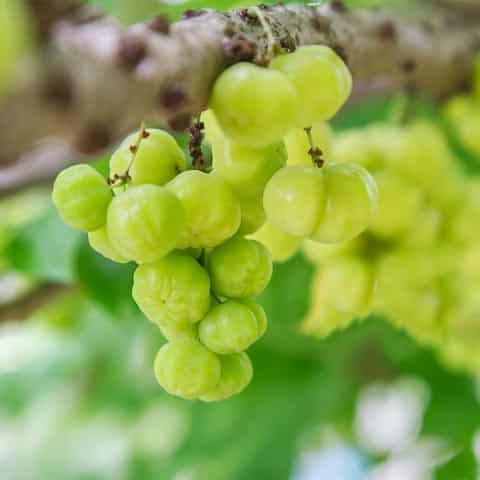
Know about plant Care for Star Gooseberry
The pomegranate is a bush or small tree that has a smooth evergreen tree with showy orange flowers. Multiple stems have a weeping habit & fruits are round & dry.
Benefits
Pomegranate leaf tea is a great drink to soothe the stomach and ease digestion issues.
It is the best fruit plant for home garden. It is rich in potassium, helps improve the blood count & supports during workouts.
Pomegranate is a good source fiber, antioxidants & Vitamin C helps to improve heart health, and cures anemia.

Know about plant care for Pomegranate
Blog created By : www.santhionlineplants.com
Traditional medicinal plants and uses are uncountable. Have you heard or seen that our Grandma’s are seeking medicines from medical shops or doctors often? No, during those days every disease & deficiency was cured by medicinal plants.
Why some of the plants are said to be medicinal & herbal plants are medicinal plants?
Herbal Plants are not medicinal plants. The medicinal plants used in Ayurveda & herbal products are plant-based extracts & medicinal plants are medicinal plant extracts & that are safe & non – toxic
Table Of Content
The tulsi is the top medicinal plant. It has enormous benefits & uses. Tulsi plants are also sacred plants for home. It has green & red leaves with pink flowers and is the most essential plant for home. As it is a sacred plant brings a lot of positive energy & harmony.
The tulsi is anti-viral, anti-microbial, anti-protozoal, anti-malarial, and anthelmintic.
Chewing two to three tulsi leaves weekly boosts immunity, and reduces cough, cold & other respiratory diseases. Additionally, it’s a stress relieving plant
Medicinal tulsi plants have many benefits cure gastrointestinal disorders, are insect repellant, and cure insect bites.
Good for kidneys, skin, & hair.

The black pepper ancient plant is native to India (Sothern regions of Kerala). The piper plant is a climber plant with year around habit and has dark green lance shaped leaves and berry fruits.
Pepper plants contain an excellent source of anti-oxidant & anti-inflammatory properties.Excellant plant in top 10 medicinal plants
The black pepper plant is an essential plant for the home as it has many benefits such as curing respiratory diseases, and digestive problems, boosts the immune system, helping in weight loss, improving brain functionalities, curing dental problems, and many others.
It has vitamins A, E, K, B6, thiamine, & Riboflavin the black pepper plant is king spice and contains Iron, copper, calcium, pottasium, manganese & phosphorous.

The Neem plant originated in India and it is the oldest medicinal plant. Neem species have many health benefits, additionally, it has timber value & organic pesticides.
Neem leaf is used for leprosy, eye disorders, bloody nose, intestinal worms, stomach upset, loss of appetite, skin ulcers, diseases of the heart and blood vessels (cardiovascular disease), fever, diabetes, gum disease , and liver problems. Pregnant ladies avoid eating Neem leaves & related products
All parts of the plant have anti-bacterial & anti-fungal properties.
Neem products organic fertilizers such as natural repellants, pesticides, and fungicides for plants. They are low toxic and most commonly used in organic farming.

This is a traditional herbal plant that supports memory, thinking, and other nerve functions apart from this it heals wounds, and various skin conditions such as leprosy, lupus, varicose ulcers, eczema, fever, and diseases of female genitourinary tract.

The Amla plant is all season bearing fruits and the tree is small to medium with a crooked trunk & spreading branches. This tree is known as the oldest popular medicinal plant.
In traditional Indian medicine, all parts of the plant are used, including the fruit, seed, leaves, root, bark, and flowers.
Amla’s benefits are enormous such as boosting immunity, good for heart health, excellent source of vitamin C for skin & hair, great plant for diabetes, and high fiber content that helps for digestion & irritable bowel movements.Amla plant is low maintenance plant.

The Lemon grass – Cymbopogon is good food and medicine. Lemon grass are perennial species and it is oily grass. It smells fresh, lemony, earthy, and sweet due to the presence of citronellal, citronellol, and geraniol are its active ingredients.
The lemon grass tea relieves stress & anxiety
Drinking lemon grass tea it reduces cholesterol & helps to activate the immune system.
Most importantly, it is an excellent mosquito repellant plant.

Bryophyllum pinnatum is a miracle plant, as life begins with a leaf. As the name Ranakalli denotes it heals wounds, insect bites, bruises, boils, and even skin ulcers.
Additionally, it is a blood purifier plant.

Check for Bryophyllum pinnatum- Ranakalli care
This khus grass -Vetiver bunch grass with medicinal properties. The name Vetiver denotes its garland of victory once the king won the war. Khus is a versatile plant belonging to the Poaceae family.
Vetiver water has cooling properties once the plants are soaked in water it cleans the impurities present in water.
Vetiver oil has many purposes in many Ayurvedic treatments.
And this is the perfect pollution control plant.

This is an ancient plant with many medicinal values. Leaves are greenish black and this is fasting growing perennial herb.
This plant species has anti-inflammatory, anti-microbial, anti-fungal properties. It relieves asthma, headache, and sinusitis by steam inhalation, leaf paste, and powder form.

Check for Black Vitex – Karunochi plant care
The Adhatoda Vasica is the traditional medicinal plant commonly called Vasaka or Malabar Nut. It is a small evergreen bush originally from the lower Himalayas. Leaves are oppositely arranged, smooth-edged, broad, lance shaped leaves borne on short petioles.
In ancient times it is the best medicine to cure respiratory disorders. The leaves contain carotene, vitamin C, and essential oil – the whole plant is sedative, and expectorant.
Adhatoda cures bronchitis, colds, whooping cough, asthma, tuberculosis, sore throat, and other lung and bronchial disorders. And also powdered leaves cure malaria and many other uses this plant has.

Check for Adhatoda Vasica plant care
All the top 10 medicinal plants have extraordinary medicinal value. Kindly, always seek advice from a medical practitioner before taking these medicinal plants.
Did you love to grow indoor plants for home? here are the best plants that you can grow indoors with low maintenance & air-purifying properties.
Indoor plants for home
Many of us think Philodendrons are money plants, but it’s not the money plant. Philodendrons have heart-shaped leaves and the leaves are soft, papery & thin.
Philodendrons are versatile plants that grow from a 1-foot length node. It gives a beautiful look plant for home.
The philodendrons are NASA-approved air purifiers, and easy-to-care houseplant thrives well in soil, cocopeat & water. The light requirement is only indirect

Check for Philodendron plant care.
Money plants are commonly called devil’s ivy, pothos,&arum. It is hard to kill a houseplant that grows perfectly both indoors & outdoors. Leaves are thicker & waxy, and stem and foliage are the same color.
Money requires at least 50% shade for both indoors & outdoors. Too much direct light may burn the leaves, and minimum low light leads to stunted growth.
Pothos are popular for low maintenance & suit best for AC rooms, office desks, meeting halls, and many others indoors. The pruning of plants is most important for healthier growth.
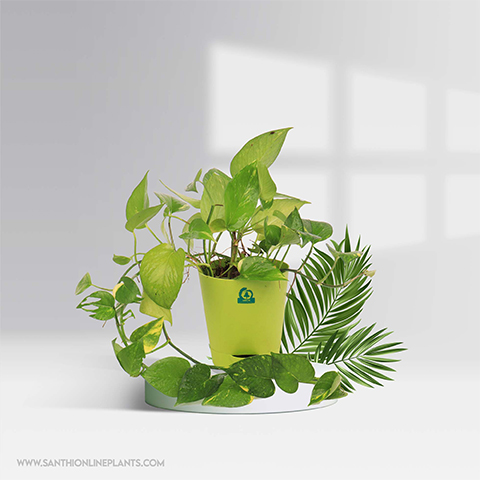
One of the striking colourful plants for indoors and the plant has shallow roots. Foliage differs in colors such as red, pink, white, crime-green, and many others.
Aglaonema plants require proper minimal care and thrive best at low lights or without light.
The Aglaonema species are lucky indoor plants for the home and bring more positive vibes & indoor plants for home decor.
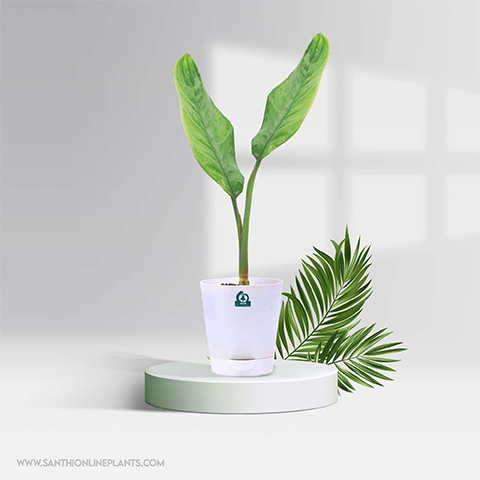
The plant has heart-shaped foliage & delights your home with different foliage. Most of the Syngonium grows as lovely creepers & others grow as the cutest upright-growing plant.
Syngonium plants are easy to care plant with very minimum light & watering. It suits best to grow indoor plants for home decor, office table tops & meeting rooms.
Researchers from NASA and other organizations have approved this plant as an air purifier, and it tops the list. Syngonium absorbs pollutants into their leaves, and the toxins go to the root zone where they are transformed into nutrients for the plant.

Check for Syngonium plant care
Nowadays, In many households, plants are placed for decoration & to maintain vastu feng shui. The snake plant is one of those known for both good looking & improving air quality at indoors.
Most people think snake plants belong to Sansevieria but it is actually a Dracaena.
By process of photosynthesis, plants clean the air by taking CO2 & releasing O2.
It is the best indoor plants for home decor.
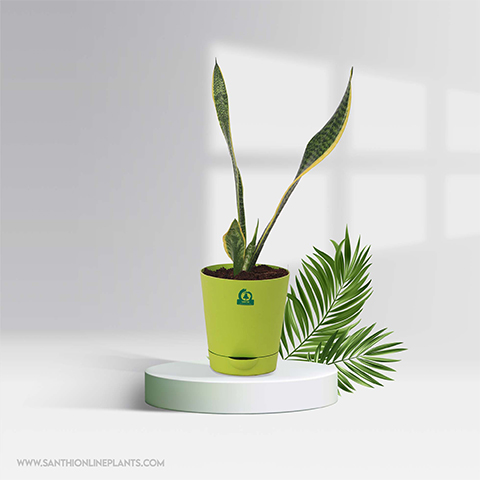
The Alocasia plants are tropical aroids that thrive best both indoors & outdoors. Leaves are long and have waxy surfaces and these Alocasia plants give aesthetic looks to all indoors & outdoors.
Most of the Alocasia are indoor plants for home & they are water-loving one. Alocasia thrives best in evenly moist soil & not soggy soil.
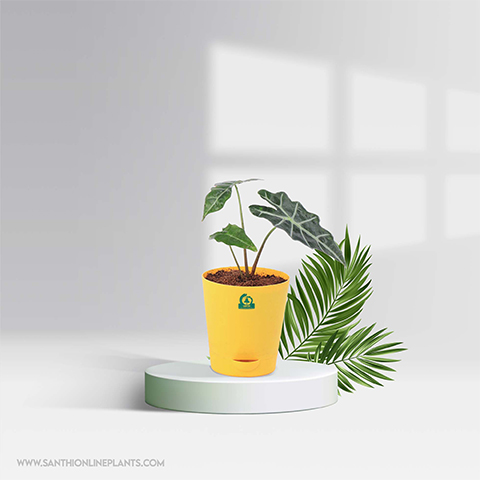
It will be a trending & new addition to your indoor plants world. This plant is popular for glossy leaves with heart-shaped, oval leaves. Plant arises from thick, waxy, succulent leaves and stems.
It is best indoors in hanging baskets, table tops, office tables & many other suitable environments.
And peperomia plants are perfect border plants.

Check for peperomia plant care
The peace lilies are the most versatile & perfect air purifier. It can be easily propagated through rhizomes. Peace lily flowers are pearl-colored and look beautiful in all types of indoor environments.
It gives the look of a green touch in any indoor environment.
Peace lilies are great at breaking down and neutralizing toxic gases like carbon monoxide and formaldehyde. And it is lucky indoor plants for home bring positive energy. Place the plants in northeast directions.

The Pedilanthus tithymaloides -Devil’s Backbone varieties & its purposes are enormous.It is the perfect, perennial herbaceous succulent that grows erect about 8 feet tall. And it is commonly called as Devil’s Backbone or Redbird cactus. The peculiarity of this plant is the Zigzag growth that resembles like ladder.

The Pedilanthus tithymaloides -Devil’s Backbone leaf is oval, slightly glossy, dark green to black color. The leaves are alternately arranged one leaf per point along the stem on opposite sides. Pedilanthus/ Euphorbia belongs to the spurge family.

The Devil’s backbone plants are redbird cactus. The flowers and bracts are located at the tip of the 1.2–1.8-metre (4-6foot) mostly leafless stems. The flower colors are pink & white.

Varieties
Pedilanthus tithymaloides-Zig Zag plant
The most important feature of this plant is attractive red flowers with fishbone-like stems in a ZigZag pattern. And Pedilanthus tithymaloides -Devil’s Backbone varieties & its purposes is enormous plant is a perennial houseplant and grows up to the height of 6 to 8 feet and has simple angiosperm foliage.

The Pedilanthus tithymaloides – Devil’s Backbone plant varieties & its purposes are more. The most prominent feature of this plant is its variegated appearance. Tiny leaves are flesh, white & stripped. This variegated devil’s backbone plant grows straight & it gives a pleasant look to the indoor environment.

It is a very popular succulent native to tropical & sub tropical North and Central America.The leaves are variegated with pale green & dark green appearance over the leaves. The pecularity of this plant is variegated pink color found over the edges. It gives an elegant look to the outdoor environment.

This variety is grow as a creeper, groundcover & hanging plant. The appearance seems to be small green leaves bent with long stems. Pedilanthus green small leaf creeps over the surface.

The plants are fleshy, green with mild serrated margins arranged on opposite sides over the leaves. Most resilient plants among the succulents.

This plant variety has pale green lovely foliage with serrated edges. Euphorbia Albino leaves arrangement in a Zigzag position. And this plant is the best border crop ornamental hedge.

Pedilanthus plants grow well even in poor conditioned soil. But grows best in sand-based soil or coco peat potting mix. Remember to keep the soil or growth medium evenly moist. Not to allow soggy water conditions.

Keep the soil moist evenly over the years, Pedilanthus plant varieties love low moisture but do not allow stagnant water over the soil or growth medium. Sprinkle the water evenly over the growth medium.

This Succulent requires Curtain-filtered sun light or bright indirect light. For longer periods, Pedilanthus does not survive direct sun light.

The application of any liquid organic fertilizer monthly over the plants as a foliar spray. Apply Bio-NPK monthly once over the plants. Do not need any feeding during the dormant season during winter & spring.
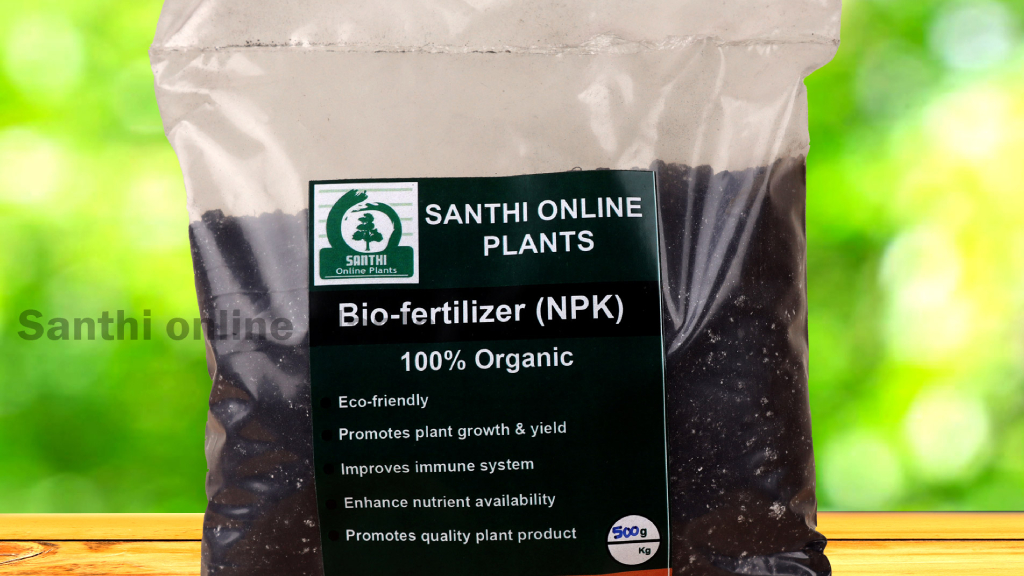
Spring season is the best time to propagate pedilanthus by stem cuttings because plants are actively growing & produce numerous roots during that time.

This plant variety does not require any pruning.
Thrives best in both indoors with bright sun light & outdoor environments with partial light with shade.
No major concern.

1)Ornamental value: The plant’s attractive green leaves and red tinted stems make it a desirable addition to any indoor or outdoor setting.
2)Low maintenance: Pedilanthus Tithymaloides is a slow-growing succulent that requires minimal care and can survive in a wide range of growing conditions.
3)Air purifying: Like many other plants, Pedilanthus Tithymaloides helps to purify the air by removes harmful pollutants and releasing oxygen.
4)Versatility: The compact size and attractive appearance of Pedilanthus make it a popular choice for use in rock gardens, as a groundcover, or as a potted plant. Also this plant is resilient plant resistant to pests & diseases and suitable for all types of gardeners.
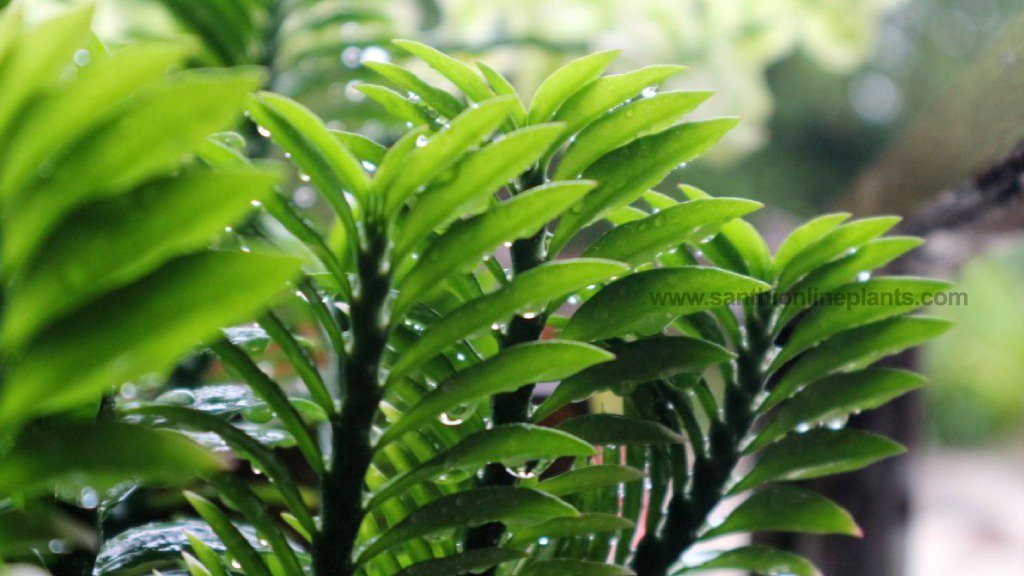
Pedilanthus plants are silent healers that purify and freshen the air around us!
For more visit www.santhionlineplants.com & make your environment green & fresh.
Acalypha Wilkesiana is the ornamental shrub and it is commonly called copperleaf or Jacob’s coat. It is an evergreen perennial ornamental shrub that can grow up to a height of 3 to 4 meters. The branches of the tree spread out in the pattern of a crown and have an erect stem.
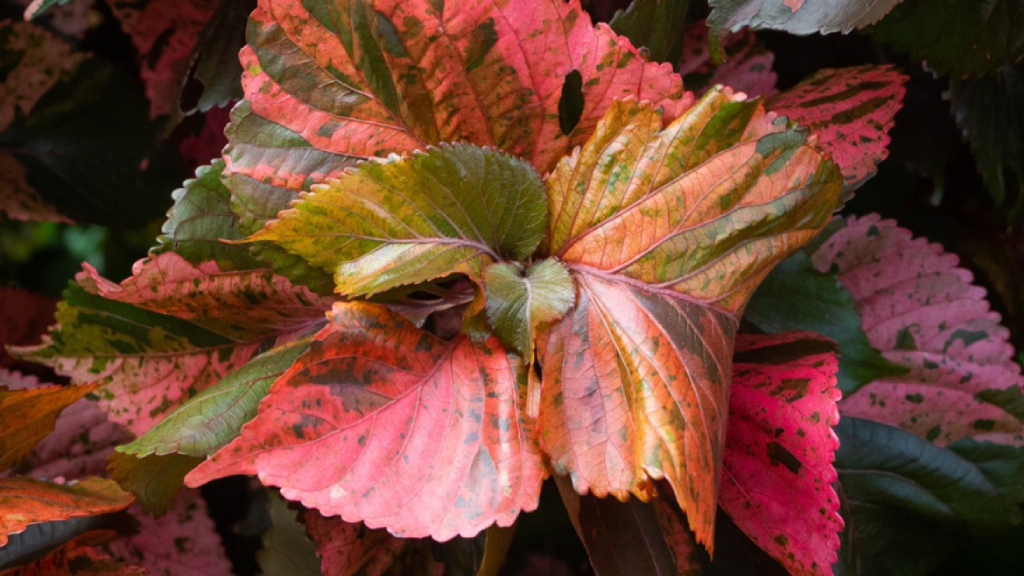
Acalypha Wilkesiana- Copperleaf plants give a stunning splash of colors to the landscape. Acalypha leaves are heart-shaped and in varying mottled combinations of green, yellow, orange, pink, or white, depending up on the cultivar.

The red, fuzzy, catkin-like flowers hang pendulously from leaf axils and are about 8 to 12 inches long. This plant produces both male & female flowers on a single plant.



As the Copperleaf plant name represents leaves are multi-colored such as initially green & changing to pink, and orange grows long with red veins & flowers. This cultivar grows up to height of 10 to 12 feet in height.
Acalypha Wilkesiana – Painted Copper Plant

It is an evergreen perennial shrub with marvelous foliage. Leaves give a bright painted appearance on the matured leaves. Initially, the foliage looks green & it turns painted appearance after some days. And this plant grows up to 2-4 feet.
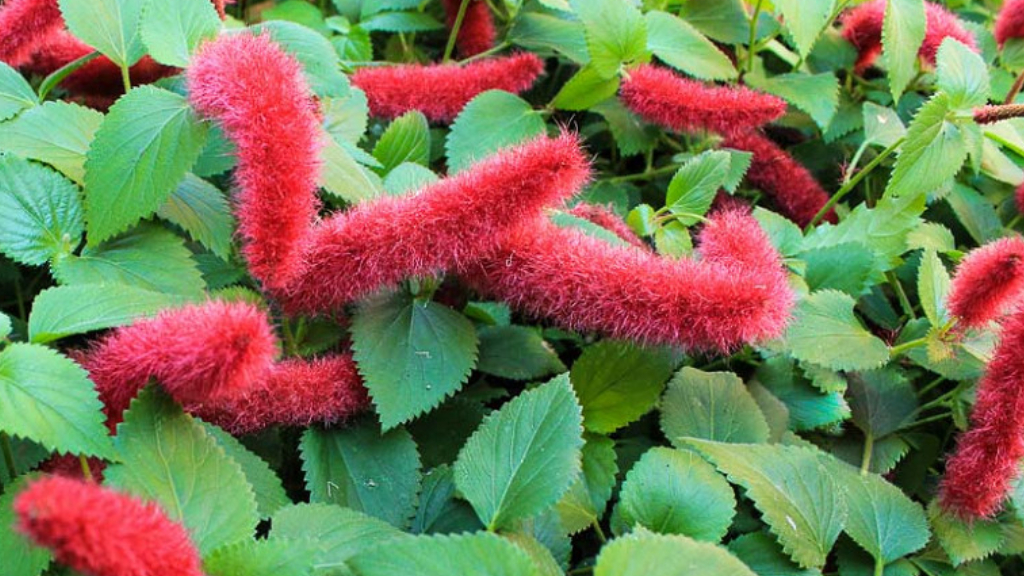
This Acalypha reptans is commonly said as the Lance leaf copper plant low growing habit with ovate leaves & dwarf with serrated margins. Flowers are pinkish red with catkin’s long woolly tail-like flowers measuring about 7-8 cm long.

It is a very good tropical plant with pale green & dark green foliage. Leaves are large & stems have a thin, woody appearance. This plant grows as a perfect ornamental & contrast foliage houseplant.

As the name represents Kona Gold has yellow, golden variegations over the leaf edges & plant has serrated margins.
The plant reaches up to the height of 12 tall.
Acalypha plant varieties love to grow in a wide range of well-drained soil or Coco peat potting mix. If the soil is not fertile apply any good organic manure over the soil at the right proportion.

Keep the soil moist evenly over the years, Acalypha plants love consistent moist but do not allow stagnant water over the growth medium.

These Acalypha plants are sun-loving plants that require lots of sunlight for about 5-6 hours. This plant also stand in partial shade.
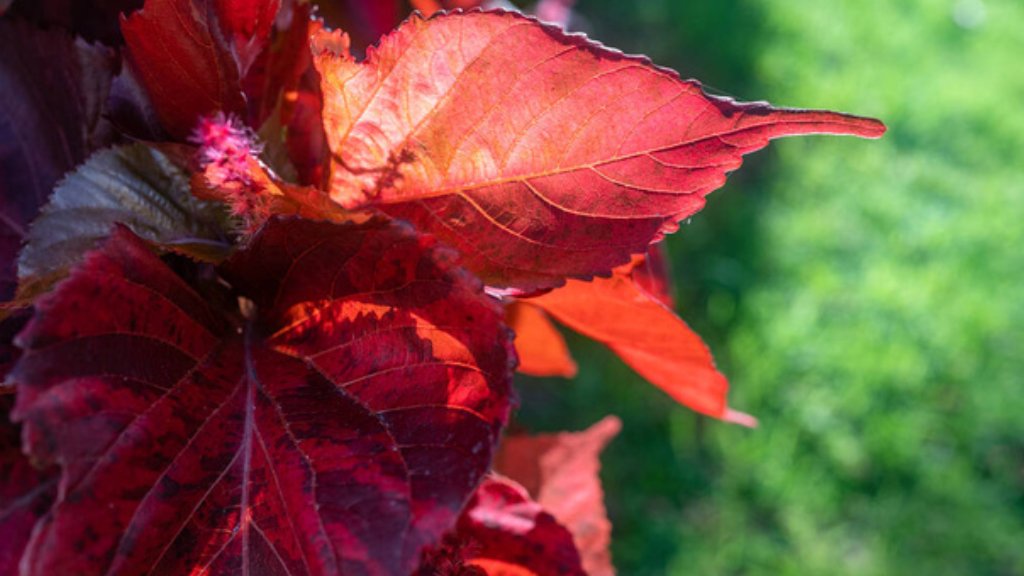
The application of phosphorus-rich bio-fertilizer helps to promote excellent root development. Young juvenile plants require more ‘Phosphorus content. The Steamed bone meal powder application in diluted form for about 2 months once around the plants results best.

The Stem tip cuttings. Select the healthy stem from a matured mother plant. Just cut those stems & propagate them in a good soil medium or coco peat potting mix.

The Acalypha plants are vigorous growers, To get a good plant appearance. Remember not to allow clusters of branches.
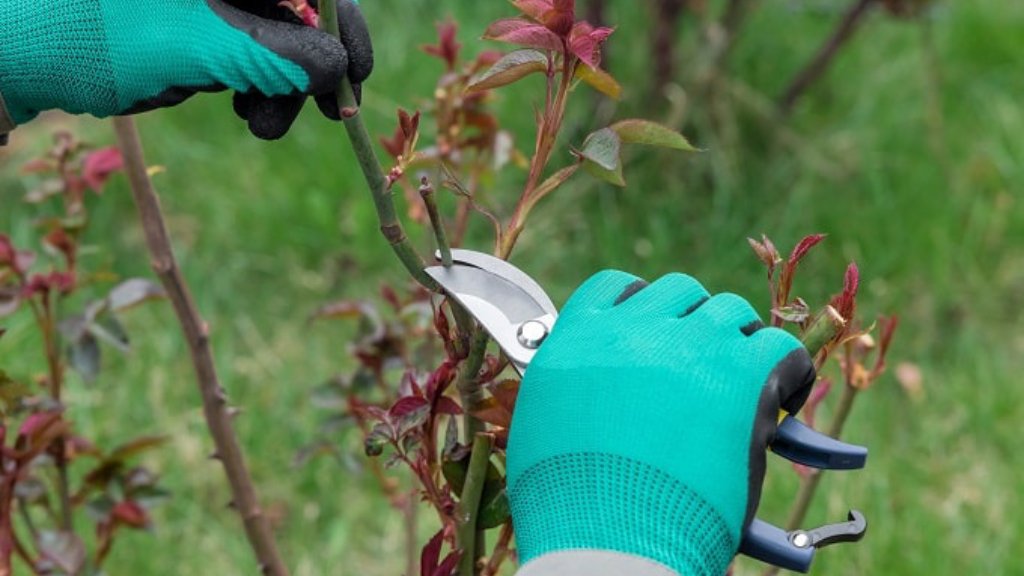
Acalypha cultivar thrives best outdoors with plant spacing of about 36 to 60 inches.
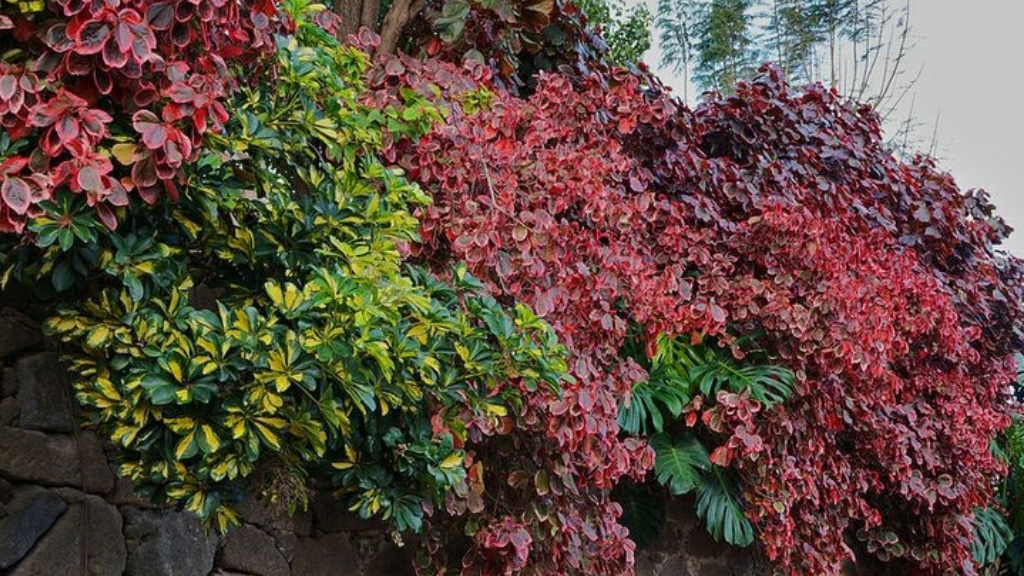
Landscaping: Acalypha wilkesiana is often used as an ornamental plant for landscaping and garden design. Its striking red, pink, or copper leaves add vibrant color to gardens and landscapes.
Flower arrangement: The brigh colored leaves are used in flower arrangements to add a pop of color.
Medicinal purposes: In some traditional medicine systems, the leaves of Acalypha wilkesiana used to treat various ailments, including skin conditions and digestive problems.
Other Uses: Mass planting, border, live hedge, container plants & screening plants.

Gardening is work for lifetime that never ends!!
For more about plants & organic products visit our website www.santhionlineplants.com go green & save green.
The pinwheel flower – tabernaemontana divaricata plants are most elegant white flowers with single,double & multi-petaled. This plant is commonly called crape jasmine in English & Nandyavarta in Sanskrit grows as shrub with high yielding white flowers.

The pinwheel flower belongs to Apocynaceae & scientifically called as Tabernaemontana divaricate. As the name crape jasmine but actually this plant does not belong to jasmine family but it has good fragrance & milky sap. It is the most reminiscent flower plant of all types of gardeners. In general pinwheel flower plant reaches up to height of 6 feet tall with mounds of glossy green leaves gives round shaped plant appearance.

The flowers are pinwheel & curved. In India pinwheel flowers are majorly has pooja & decoration values such as in garland & bouquet preparations.

The name Nandyavarta in Sanskrit & nandhiyavattai in English . It is the magical plant has many medicinal properties & used in Ayurveda. Act as anti-inflammatory & milky sap is good for our eyes.

This plant is dichotomously branched and grows to a height of 1.5–1.8 meters (5–6 feet). The huge cluster of leaves is around 15 cm (6 in) long and 5 cm (2 in) wide and are deep green. Cute mini clusters of waxy blooms observed on the stem tips.

Vivasaya Nanthiyavattai grows everywhere in the tropical and subtropical regions. The leaves are enormous, lustrous, and deep green. The (single) blooms feature the distinctive ‘pinwheel’ shape with strong fragrance in the evening.
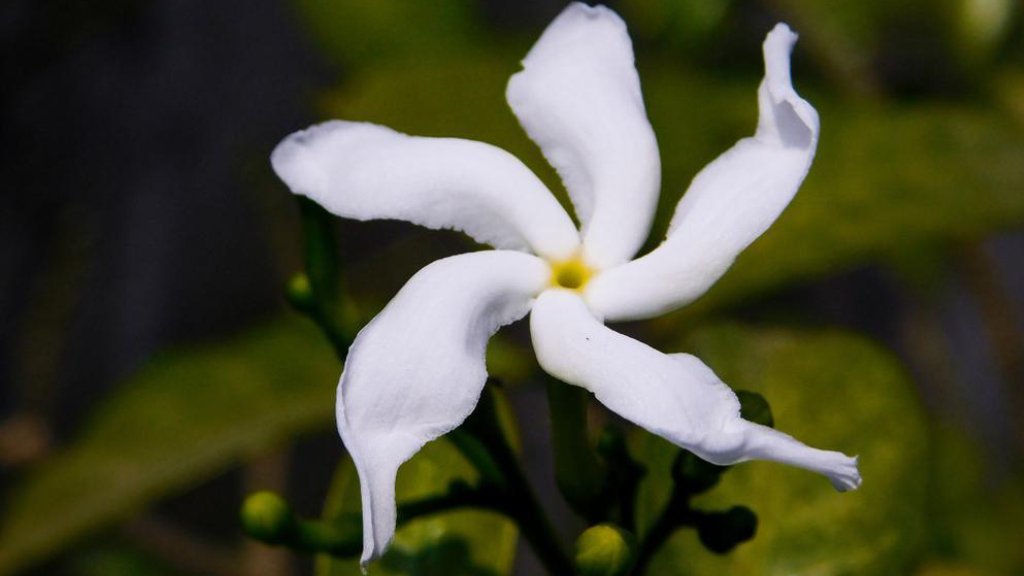
Most beautiful flower crop plant has attractive leaf foliage. Leaves have white streak all over the surface. Flowers are regular pinwheel shaped. It gives contrasting graceful look to the environment.

This variety crape jasmine flowers are curled at edges has perfect circle flowers and fast growing evergreen perennial flower plant. It gives flower yield year around.

This pinwheel flower plant requires humus rich moist soil, somewhat acidic & well-drained soil helps to have finest flower & foliage.
Also this plant grows well in coco peat potting mix.
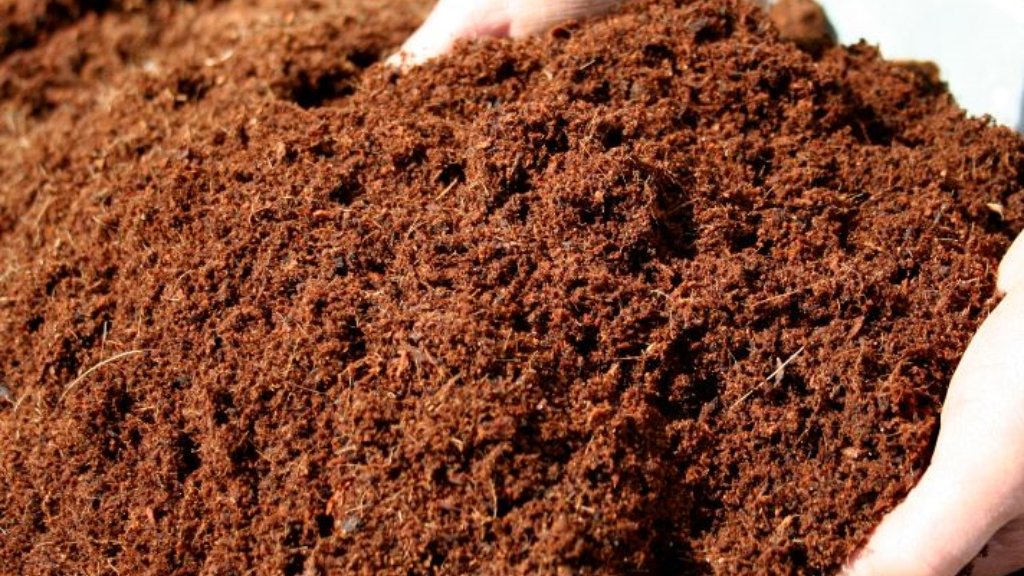
As its tabernaemontana divaricata are drought tolerant plants. Water the plants weekly twice on alternate days in a week. Crape jasmine plant does not like standing or stagnant water.

This flower plant requires direct sunlight of 4-5 hours with partial shade. Flower prefers shade for lovely bloom. Do not place the plants in continuous direct sunlight.

To get optimal flower bloom fertilize the plants with bio-fertilizer or organic fertilizer monthly once around the plants. Preferably phosphorus rich fertilizer steamed bone meal in diluted form application promote high flower bloom.
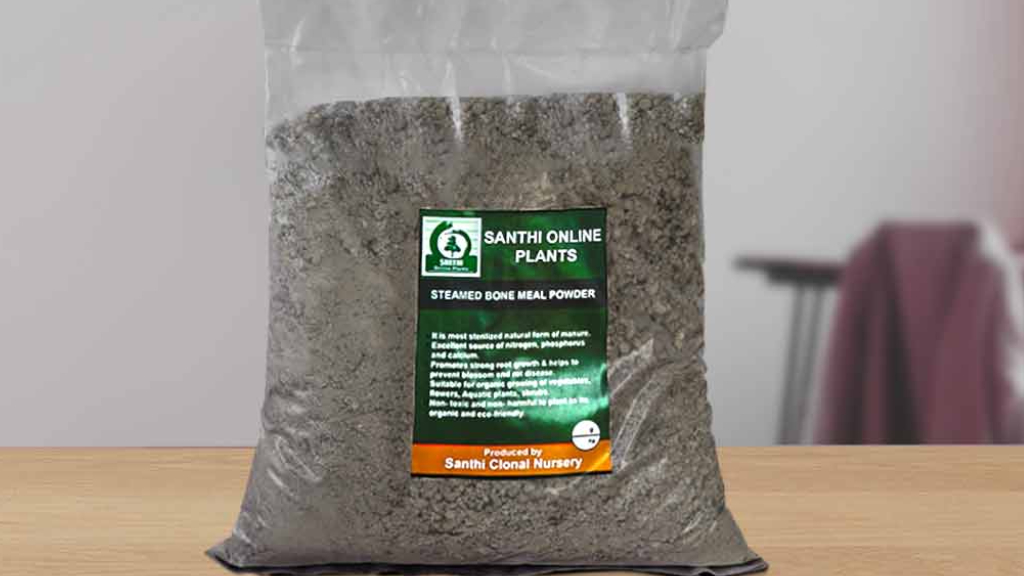
Propagation done through stem cuttings. Take a 15 cm cutting from the top of the stem, cutting just below a leaf node. Remove the leaves from the lower part of the stem. Place it in moist soil or cocopeat potting mix.

Prune the plants to get perfect compact structure. Prune the lower branches of the plant to get more branches out.

During rainy season, this flower plant affected by leaf roller pest. Application Neem oil in diluted form helps the plant to grow disease & pest free.


Greenery plays a strategic role in making the world more beautiful. Green Plants provide essential biodiversity, ecosystem services, carbon sequestration and helps to reduce the Urban Heat effect.

For the love of planet,keep it Green!!
Blog Created By: www.santhionlineplants.com
Adenium plant is a popular succulent plant and indoor bonsai plant. The adenium plant also called as “desert rose” and this adenium plant belongs to the Apocynaceae family. Adenium desert rose are known for unique appearance and beautiful star-shaped flower. And most commonly cultivated variety is “adenium obesum”. These desert roses grow up to a height of 3 feet to 6 feet tall. And “adenium somalense” naturally tends to grow up to a height of 6 to 10 feet.
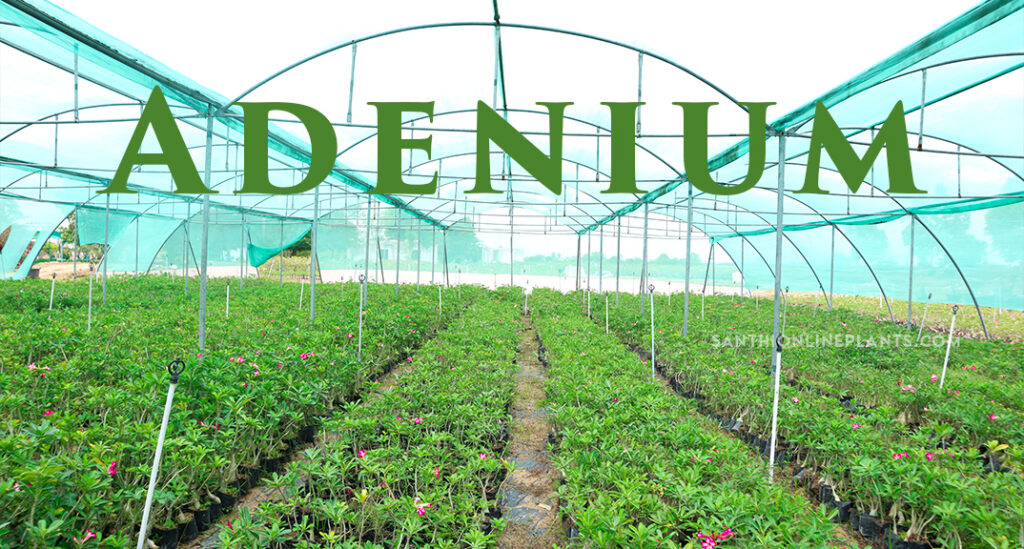
Adenium desert rose requires an abundant amount of care. These desert rose requires bright light and indirect sunlight. These desert rose are grow in mild hot areas.

These adenium desert rose has attractive foliage, star shape, and their symmetrical pattern of petals that give a unique appearance. Adenium desert roses have a wide range of color shades that includes pink, white, red, and purple and some varieties have bi-color and multi-color too. The size of the flower varies from growing conditions generally adenium desert rose flowers scale 2 to 4 inches.
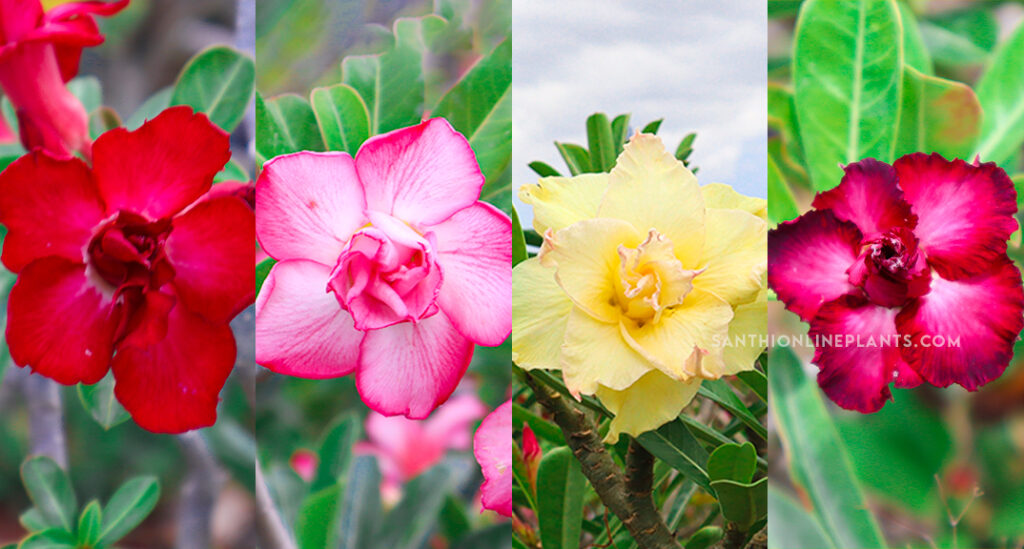
Soil
Soil should be on the PH scale of 6.5 to 7.0. These desert rose requires well-draining soil that helps to prevent waterlogging to avoid root spoiling. A normal mixture of Bio-NPK with sand goes well for the growth of adenium.

Adenium desert rose are succulents that don’t require more water for their growth. While watering these require a less amount of water so to ensure after watering the top layer should be dry and water shouldn’t stay in the pot. It’s better to water frequently in the growing season and reduce watering in the winter season.
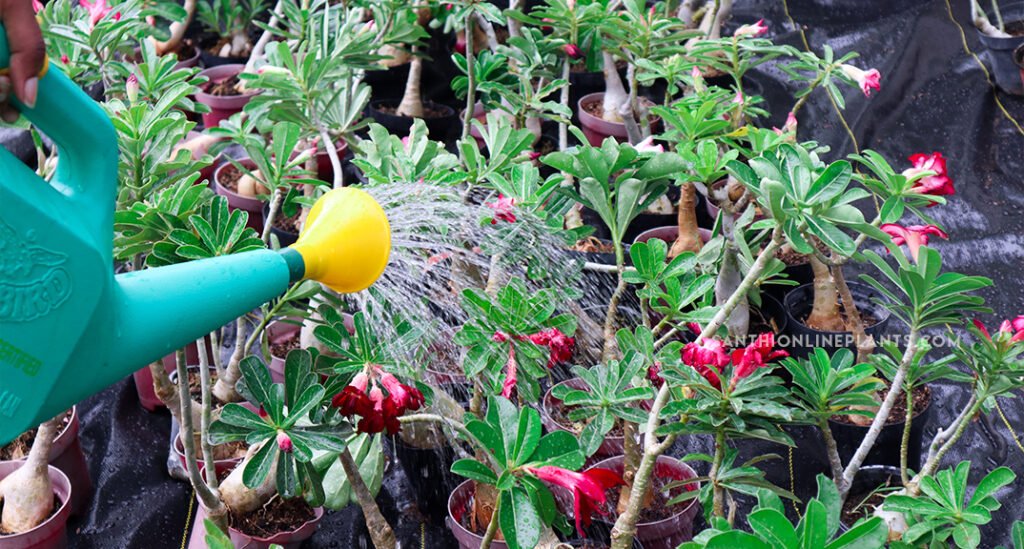
Desert rose plant requires bright light and indirect sunlight. Desert rose are grow both in outdoors and indoors. In outdoor conditions, they need to be placed in a shade receiving area to avoid high temperatures.

Treat desert rose plant with Bio-NPK. Organic fertilizers such as seaweeds and composted materials are used in the growth of desert rose plants. The Desert rose plant is a slow-growing plant it only requires few nutrients. Application of steamed bone meal increase the colour of flower.
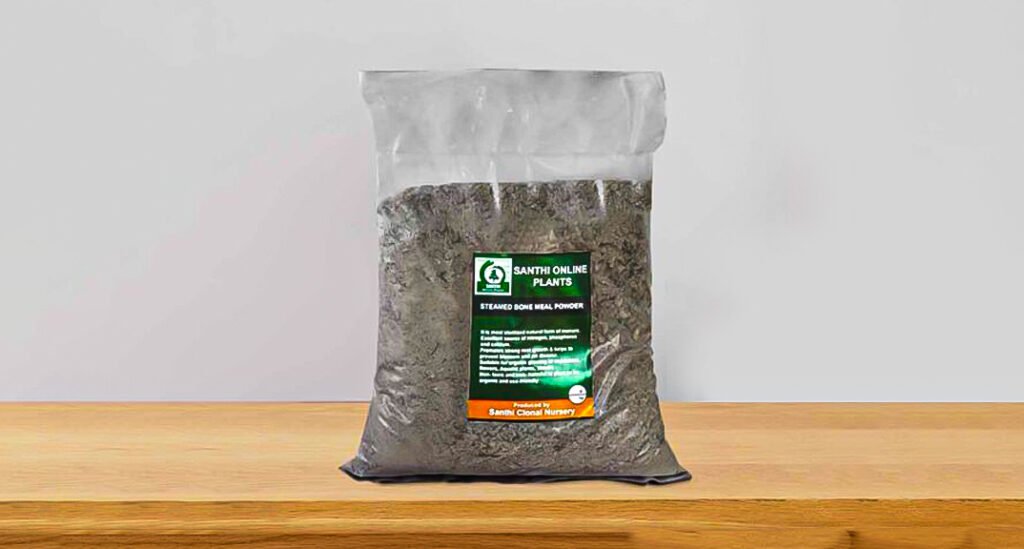
Desert rose plants propagated through stem cuttings, seeds and grafting. For stem cuttings choose a healthy mother plant. The other technique is grafting in which join a piece of scion onto different rootstock.

Pruning in this plants by cutting the infected branch helps to encourage new branching and by removing dead parts which helps in the efficient growth of this plant

Adenium plants are repotted after two years of planted. For repotting, the pot should be large and filled with well-draining soil.

Initial stage of growth plant need 2-3 hours of sunlight. After maturity it requires 6-8 hours of sunlight.
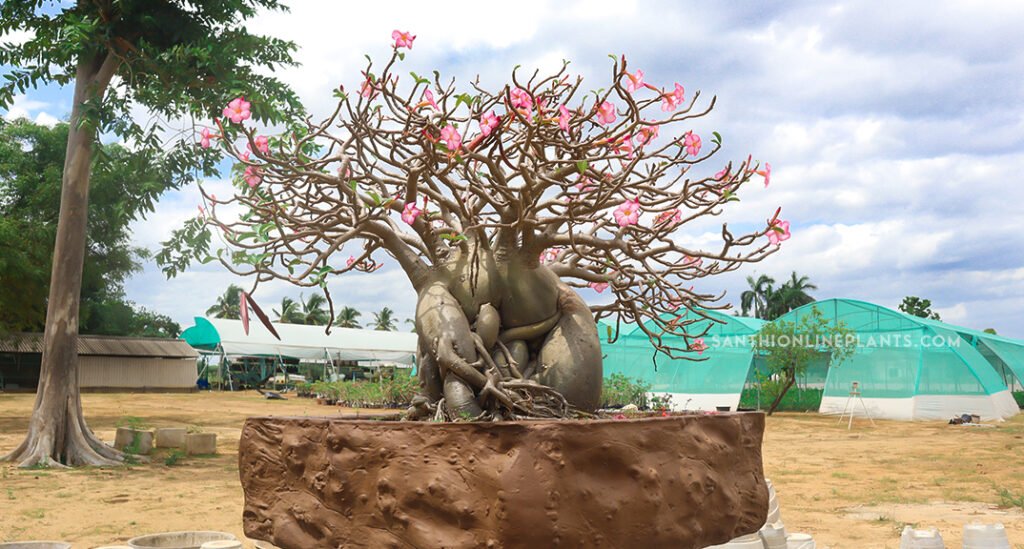
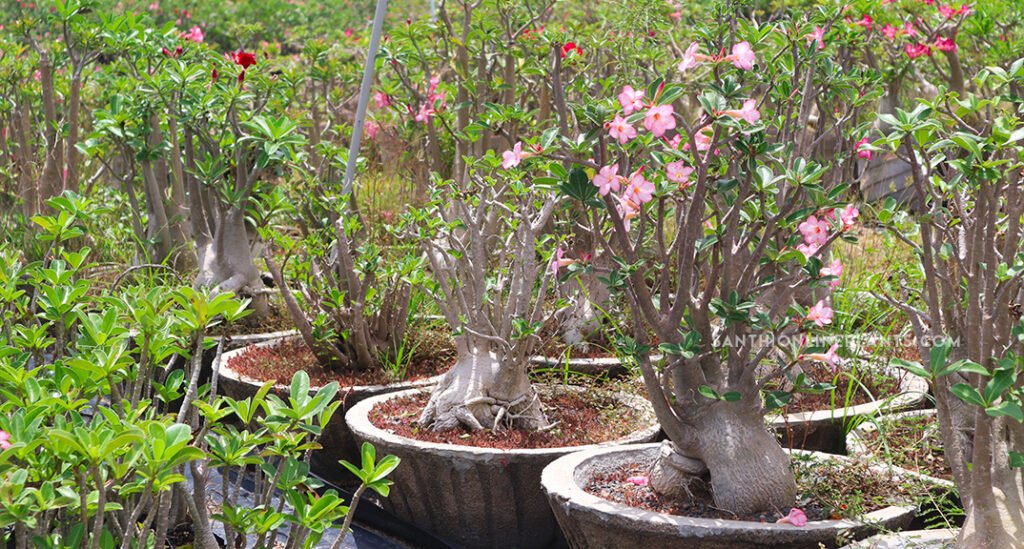
Bonsai plants filter the air and remove toxins and maintain moisture inside the home. It is also considered as wealth building vastu plant.
For more oxygen plant more trees
Blog created by : Santhionlineplants
Purple heart is a perennial hanging plant that belongs to the family spiderwort and it is majorly grown for its shiny purple foliage. And purple heart plant is traced to be originated from Eastern Mexico. This plant is also as called a purple queen or wandering Jew. And this hanging flower plant grows up to a height of 15-30 cm and wide of 30-45cm. Purple heart plants are classified as hanging plants due to their trailing characteristics.

Purple heart plants prefer indirect light; they can also grow in full sun which makes their foliage full dark purple. This variety is propagated by stem cuttings. The plant is propagated in soil remove a few leaves from the bottom of the stem. And if it is propagated in water keep a lower portion with leaves. Always keep the plant in indirect sunlight which is good for root development.

Purple heart prefer PH around 6.0 to 7.0. Use good quality potting mix that provides good aeration and drainage. But the soil should be light then the roots can penetrate easily. Avoid heavy soil this leads the root system to suffocate for aeration. Induce the plants with additional nutrients such as cow manure, and goat manure.

The minimum amount of water is sufficient for a purple heart. Avoid over watering this lead to root rot. Watering once a week is more than enough for purple heart. Pour enough water if leave turn brown or yellow.

They prefer bright, indirect light. Prolonged sunlight can lead the leaves to burn. At the same point if the plant doesn’t receive enough light its foliage may lose its purple color slowly. Maintaining a balanced amount of light can keep the foliage purple and plants healthy.

Abundant amounts of sunlight can lead the plant to produce pink and purple flowers. In purple heart, plant foliage is more attractive than flowers. This hanging flower plants grow densely.

Induce bio NPK, cow manure, and goat manure at the base of the plants monthly once can lead the plants to grow at optimum levels with healthy purple foliage.

Prune the plant to achieve desired shape and size. If the plant in ground cover trim monthly once for uniform appearance. After pruning remove all dead, damaged leaves to keep the plant healthy.

Transplant the plant during early spring while it is actively growing. Repotting is required because roots penetrate very fastly. Watering is so essential for plants after repotting. And avoid direct sunlight that affects the foliage.


Hanging plants are good air purifying indoor plants and that increase humidity and reduce hypertension and gives a positivie instinct.
Blog Created by: Santhionlineplants